난청과 귀머거리, Hearing difficulty and Deafness
난청과 귀머거리의 개요
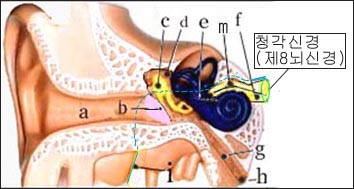
그림 88. 외이도, 중이, 내이 또는 뇌에 어떤 이상이 있을 때 난청이 생기거나 귀머거리가 될 수 있다.
a-외이도, b-고막, c-이 소골, d-중이, e-와이관, f-와이신경, g-이관, h- 이관 입구 i-안면신경(제7 뇌신경), m-전정신경.
Copyright ⓒ 2011 John Sangwon Lee, M.D., FAAP
- 미국에서 연간 1000명의 생존 신생아들 중 1~3 명에게 청력 장애가 있다.
- 언어 장애와 말 장애를 일으킬 수 있는 청력 장애를 갖고 태어난 영아들이 연간 4000~12000명이 된다고 한다(출처; Pediatrics May 2008, p.970).
- 한쪽 귀나 양쪽 귀로 정상적으로 들을 수 없는 청력을 난청이라 하고
- 조금도 들을 수 없으면 귀머거리 또는 농아라 한다.
- 청력이 전부, 중등도로 상실될 수 있고 일부 상실될 수 있다.
- 농이 있는 아이를 농아, 또는 귀머거리 아이라고 하고
- 귀가 완전히 먹으면 말을 할 수 없어 자연히 벙어리가 된다.
- 청력 상실이나 청력 감소는 사람의 5 감각 기관 문제들 중 가장 흔한 감각 문제이다.
- 65세 이상 노인층의 10%가 청력 상실 내지 난청이 있다.
청력 상실과 청력 감소의 분류
① 원인에 따라,
- 유전성
- 또는 비 유전성으로 분류하고,
② 증후군과 함께 있느냐 없느냐에 따라,
- 증후군성 청력 상실과 청력 감소,
- 비 증후성 청력 상실과 청력 감소로 분류할 수 있고
③ 말을 배우기 시작하기 전에 생겼는지, 또는 말을 배운 후에 생겼는지에 따라
④ 청력 신경 이상으로 생긴
- 청력 신경성 청력 상실과 청력 감소인지,
- 또는 전음 이상으로 생긴 전음성 청력 상실과 청력 감소인지로 분류할 수 있고
⑤ 청력 상실의 정도에 따라
- 경도 청력 상실(21~40dB 상실),
- 중등도 청력 상실(41~60dB 상실),
- 중등도 청력 상실(61~80dB 상실),
- 심한 청력 상실(81~100dB 상실),
- 또는 극심한 청력 상실(100dB 이상 상실)로 분류할 수 있고
⑥ 헤르츠 치에 따라
- 저 청력 상실(500㎐ 이하),
- 중간 청력 상실(501~2000㎐)
- 고 청력 상실(501~2000㎐)로 분류하기도 한다.
난청과 귀머거리의 원인
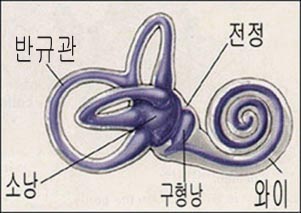
그림 90. 전정, 청신경(청각신경)과 와이 22.
청각신경에 이상이 있거나 뇌에 이상이 있어도 청력에 이상이 생길 수 있다.
Copyright ⓒ 2011 John Sangwon Lee, M.D., FAAP
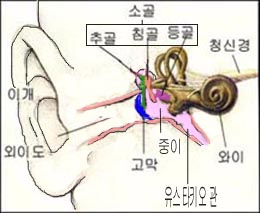
그림 89. 외이, 내이, 중이 22.
외이, 내이, 중이, 또는 청각신경(청신경)에 이상이 있거나 뇌에 이상이 있어도 청력에 이상이 생길 수 있다.
Copyright ⓒ 2011 John Sangwon Lee, M.D., FAAP
- 귀는 해부학적으로 외이, 중이, 내이로 구성된다.
- 이중 한 부분이나 두 부분, 또는 전부 이상이 있을 때 청력에 이상이 생길 수 있고,
- 물론 청력신경이나 뇌에 이상이 있어도 청력 문제가 생길 수 있다.
- 선천적인 원인이나 후천적인 원인으로 난청이나 귀머거리가 생길 수 있다.
태어날 때부터 전혀 들을 수 없는 귀머거리를 선천성 귀머거리 또는 선천성 농아라고 한다.
- 타고날 때부터 청력이 비정상적으로 감소된 경우를 선천성 난청이라 한다.
- 선천성 난청이 있는 아이들은 큰 소리나 고음을 어느 정도 들을 수 있으나 작은 소리나 저음은 들을 수 없다.
- 태어날 때는 청력이 정상이지만 생후 난청과 귀머거리가 여러 가지 원인에 의해서 후천적으로 생길 수 있다.
- 어떤 난청과 귀머거리는 유전으로 인해 생길 수 있다.
- 귀가 거의 먹을 수 있을 정도로 심한 난청도 있다.
- 난청이나 귀머거리가 유전적 원인으로 생길 수 있다. 그래서 그 집안 식구들 중 여러 식구들에게 난청이 있거나 귀머거리가 있을 수 있다.
- 바알덴버그(Waardenburg) 증후군,
- 우셔(Usher) 증후군,
- 펜드레드(Pendred) 증후군,
- 또는 알포트(Alport) 증후군 등이 있을 때 청력이 상실될 수 있다.
- 임신 첫 3개월 기간 중 태아가 풍진에 걸리면 태아에게 청력장애를 비롯한 태아풍진 증후군이 생길 수 있고 태어난 후 난청 또는 귀머거리가 생길 수 있다.
- 임신 중 거대세포바이러스(Cytomegalovirus)에 감염된 임신부에게 태어난 아기에게 난청 또는 농아가 생길 수 있다. 전정 장애 (Vestivular disoders),균형장애, 주시 장애(Gaze disoders)
- 청력 이상이 있는 신생아들의 6%는 태아거대세포바이러스 감염으로 생겼다고 한다(출처; Pediatrics May 2008, p.970).
- 분만 전, 분만 중, 또는 분만 후 생긴 태아 산소결핍증으로 뇌손상이 생겨 그로 인해 난청이나 귀머거리가 생길 수 있다.
- 아주 작은 미숙 신생아들에게 생긴 황달이나 만삭에 태어난 신생아들에게 생긴 황달로 인해 핵황달이 생길 수 있고 뇌가 손상될 수 있고 그로 인해 난청이나 귀머거리가 생길 수 있다.
- 뇌막염, 뇌염, 뇌 손상 등으로 난청이 생기거나 귀머거리가 될 수 있다.
- 난청이 감염성 이하선염(멈푸스/볼거리)으로 비교적 잘 생길 수 있다(출처-Pediatric News, July 2007).
- 급성 중이염이나 만성 중이염 또는 재발성 삼출성 중이염, 고막 파열, 귀 외상 등으로 난청이나 귀머거리가 될 수 있다.
- 심한 외이도염, 외이도 내 귀지, 외이도 내 이물 등으로 일시적 난청이 생길 수 있다.
- 카나마이신, 젠타마이신, 스트렙토마이신, 또는 그 외 여러 종류의 항생제의 부작용이나 다른 약물 치료의 부작용으로 인해 난청이나 귀머거리가 될 수 있다.
- 기타
난청과 귀머거리의 증상 징후
- 난청이나 귀머거리의 증상 징후는 원인과 청력 상실의 정도에 따라 다르다.
- 태어날 때부터 조금도 들을 수 없는 신생아 농아는 주위에서 큰 소리가 나도 조금도 반응하지 않고 놀래지도 않는다. 모로 반사가 나타나지 않는다.
- 생후 2~4개월 된 영아들의 대부분은 엄마 아빠나 식구들의 친밀한 말이나 보통으로 나는 소리를 듣고 웃고 아기 소리를 내어 정상적으로 화답할 수 있다.
- 그러나 귀가 먹은 영아들은 아기 소리를 조금도 내지 못하며 큰 소리가 나는 쪽으로 머리를 돌리지도 않는다.
- 생후 6~9개월 이후 영아들의 대부분은 누가 자기 이름을 부르거나 전화벨이 울리면 알아듣고 반응하는 것이 보통이지만 귀가 먹은 영아들은 전혀 알아듣지 못하고 반응하지 않는다.
- 생후 12~15개월 대부분의 유아들에게 자기 귀나 코를 가리키라고 하면 가리킬 줄 알고 적어도 한두 단어를 써서 말을 할 줄 아는 것이 정상이다.
- 심한 난청이 있는 영유들은 한마디 말도 정상적으로 배우지 못하거나 언어 발육이 비정상적으로 지연될 수 있다.
- 귀가 먹은 영유아들은 제 때에 말을 조금도 하지 못한다.
- [부모도 반의사가 되어야 한다-소아가정간호백과]-제 3권 신생아, 영유아, 학령기와 사춘기 아이들의 성장발육-생후 6개월에서 8개월까지 성장 발육 참조.
그 동안 정상적으로 잘 알아듣던 아이가 말을 잘 알아듣지 못하고 다음과 같은 증상이 나타나면 난청이나 귀머거리를 의심 한다.

사진 91. 약물치료로 난청이 생길 수 있다.
Copyright ⓒ 2011 John Sangwon Lee, M.D. FAAP
-
텔레비전의 음량을 보통 이상으로 크게 틀어 놓는다.
- 학교 성적이 별 이유 없이 떨어진다.
- 부모나 다른 사람들의 말을 잘 알아듣지 못한다. 그
- 아이에게 무슨 말을 할 때 같은 말을 여러 번 반복해야 한다.
- 심한 난청이 있는 아이에게 말하는 사람의 입의 움직임을 관찰하고 눈치로 그 사람의 말을 대강 알아듣는다.
- 귀가 먹으면 말을 전혀 알아듣지 못하고 말을 할 줄도 모르면 농아(聾啞)라고 한다.
- 급성 중이염, 만성중이염, 재발성 중이염,삼출성 중이염 등으로 난청이 생길 수 있다.
- 중이염으로 생긴 난청을 적절히 잘 치료해 주면 청력이 정상적으로 회복되는 것이 보통이다.
- 난청이 있는 아이는 말을 제 나이에 제대로 배우지 못해 언어 발육이 또래들보다 훨씬 더 늦어질 수 있다.
- 귀가 먹은 아이들은 아무 말도 알아들을 수 없기 때문에 말을 전혀 배울 수 없고 한 마디 말도 할 수 없다.
- 한쪽 귀만 난청이 있는 아이들이나 한쪽 귀가 완전히 먹은 아이들은 또래들과 같이 정상적인 한쪽 귀로 거의 다 알아들을 수 있고 정상적으로 말을 배우고 말을 할 수 있다.
- 한쪽에만 난청이 있거나 한쪽 귀가 완전히 먹은 아이에게 청력 이상이 있는지 잘 모르고 지낼 수 있다.
- 한 쪽에만 난청이 있거나 한 쪽 귀만 먹은 아이는 소리 나는 방향으로 정상적인 귀를 돌리는 경향이 있다.
난청과 귀머거리의 진단
- 난청의 중증도에 따라 진단 방법이 다르다.
- 병력, 증상 징후와 진찰소견 등을 종합해서 난청이나 귀머거리가 의심되면 청력검사를 해서 진단한다.
- 한쪽 귀에 청력 이상이 있는 아이가 소아청소년과에서 소아 건강 검진을 받을 때 난청이 있다는 것을 처음 진단 받을 때도 있다.
- 중이염이나 고막 파열 등으로 생긴 난청은 이경으로 진찰해서 쉽게 진단할 수 있다.
- 이비인후과에서 자세한 진찰을 받고 난청이나 귀머거리가 왜 생겼는지 원인을 알고 진단해서 원인에 따라 치료받는다.
- 필요에 따라 난청은 적절한 보청기 등으로 치료한다.
- 난청이 있거나 귀가 먹은 것 같으면 청력검사를 받는다.
- 미국에서는 병원에서 출생한 모든 신생아들은 법에 의해 기본적으로 청력검사를 받아야한다.
- 소아청소년과에서 정기 건강검진을 할 때마다 청력검사를 통상적으로 한다.
- 신생아 청력 검사는 이음향반사(Otoacoustic emissions) 검사나 청성뇌간반응(Auditory brainstem response) 검사로 하는 것이 보통이다.
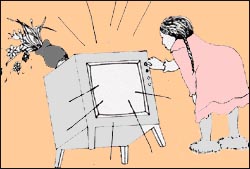
그림 92. 청력이 좋지 않으면 언어발육이 늦거나 큰소리로 말하거나 TV를 크게 틀거나 잘 알아듣지 못한다.
Copyright ⓒ 2011 John Sangwon Lee, M.D., FAAP
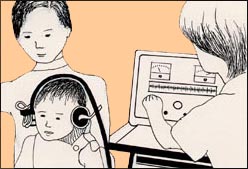
그림 93. 청력에 이상이 있다고 의심되면 소아청소년과에서 검진을 받고 소아청소년과의 소개를 받아 이비인후과에서 진찰을 받고 청력검사를 한다.
Copyright ⓒ 2011 John Sangwon Lee, M.D., FAAP
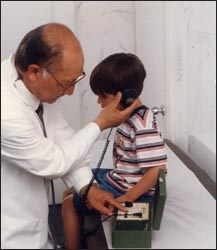
사진 94. 소아청소년과에서 시계 똑딱 소리, 손바닥비비기 소리, 작은 말소리 등으로 청력 선별검사를 간단히 할 수 있고 간단한 청력검사 기계로 소아 청력을 검사할 수 있다.
Copyright ⓒ 2011 John Sangwon Lee, M.D., FAAP
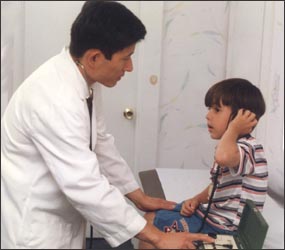
사진 95. 더 자세한 청력을 검사하기 위해서는 청력 검사전문가가 청력을 검사할 수 있다.
Copyright ⓒ 2011 John Sangwon Lee, M.D., FAAP
난청과 귀머거리의 치료
- 일시적인 난청이 중이염으로 생길 때는 중이염을 적절히 치료해 주면 난청이 잘 낫는다.
- 특히 심한 삼출성 중이염이나 만성 중이염으로 난청이 생길 수 있다. 심한 삼출성 중이염이나 만성 중이염을 치료 하면 난청도 회복된다.
- 전에 잘 듣던 아이가 갑자기 잘 듣지 못하면 중이염이 있는지, 또는 다른 이상이 귀에 있는지 의사의 진찰 진단과 치료를 곧 받아야 한다.
- 난청을 보청기로 치료받을 때 아이의 난청치료에 적절하고 그 아이의 귀 크기에 맞는 적절한 보청기를 선택하고 사용법에 따라 보청기를 잘 사용해야 한다.
- 보청기로 청력이 회복 되지 않고 양측 난청이 있는 환아가 인공 와우 이식 치료를 받고 거의 정상적으로 잘 들을 수 있고 정상적으로 언어가 발육될 수 있다.
- 모든 방법으로 청력이 회복되지 않으면 적령에 농아학교에 보내야 한다.
- 약물 중독이나 약물 부작용 등으로 생긴 난청은 정상적으로 점차로 회복될 수 있고 청력이 완전히 상실될 수 있다.
- 약물로 어떤 병을 치료받을 때는 청력 이상이 생기나 항상 조심해야 한다.
Medical News | Physician’s First Watch March 2, 2016 60% of Childhood Hearing Loss Preventable, WHO Says By the Editors Roughly 60% of childhood hearing loss is preventable, according to a report from the World Health Organization. Some of the preventable causes include rubella, measles, mumps, meningitis, low birth weight, premature birth, birth complications, and ototoxic medicines (e.g., those used to treat malaria and drug-resistant tuberculosis). The agency calls for strengthening immunization programs, prenatal care, hearing screening, and early intervention programs. 3/2016
Hearing difficulty and Deafness
Overview of Hearing Loss and Deafness

Figure 88. Deafness or deafness can occur when there is something wrong with the outer ear canal, middle ear, inner ear, or brain. a-external auditory canal, b-tympanum, c-ossicles, d-middle ear, e-cochlear canal, f-wy nerve, g-ear canal, h- entrance to ear canal i-facial nerve (7th cranial nerve), m-vestibular nerve. Copyright ⓒ 2011 John Sangwon Lee, M.D., FAAP
• In the United States, 1 to 3 out of every 1000 surviving newborns per year are deaf.
• It is estimated that 4000 to 12,000 infants are born each year with a hearing impairment that can cause speech and language impairments (source; Pediatrics May 2008, p.970).
• Hearing loss in which one or both ears cannot hear normally is called deafness.
• If you cannot hear at all, you are deaf or deaf.
• Hearing may be completely, moderately or partially lost.
• A child with deafness is called a deaf or deaf child.
• If your ears are completely deaf, you will not be able to speak and will naturally become dumb. • Hearing loss or hearing loss is one of the most common sensory problems in humans.
• 10% of people over the age of 65 have a hearing loss or hearing loss.
Classification of Hearing Loss and Hearing Loss
① Depending on the cause,
• hereditary
• or classified as non-hereditary;
② Depending on the presence or absence of the syndrome,
• Syndrome hearing loss and hearing loss;
• can be classified into non-symptomatic hearing loss and hearing loss;
③ depending on whether it happened before you started learning to speak or after you learned to speak
④ Hearing nerve abnormalities
• Cognitive hearing loss and hearing loss;
• Or it can be classified into conductive hearing loss and hearing loss caused by conductive abnormalities. ⑤ depending on the degree of hearing loss
• Mild hearing loss (21-40 dB loss);
• Moderate hearing loss (41-60 dB loss);
• Moderate hearing loss (61-80 dB loss);
• Severe hearing loss (81-100 dB loss);
• or severe hearing loss (loss of 100 dB or more) and ⑥ According to the Hertz value
• Low hearing loss (500 Hz or less);
• Moderate hearing loss (501~2000Hz)
• It is also classified as high hearing loss (501~2000Hz). Causes of hearing loss and deafness

Figure 90. Vestibular, auditory nerve (auditory nerve) and Y 22. If there is a problem with the auditory nerve or if there is a problem with the brain, there may be a hearing problem. Copyright ⓒ 2011 John Sangwon Lee, M.D., FAAP

Figure 89. Outer, inner, and middle ear 22. If there is an abnormality in the outer ear, inner ear, middle ear, or auditory nerve (auditory nerve), or there is an abnormality in the brain, hearing abnormality may occur. Copyright ⓒ 2011 John Sangwon Lee, M.D., FAAP
• The ear anatomically consists of the outer, middle, and inner ear.
• Hearing loss can occur when one, two, or all of these parts are defective;
• Of course, hearing problems can occur even if there is an abnormality in the auditory nerve or brain.
• Hearing loss or deafness may occur due to congenital or acquired causes.
Deaf people who cannot hear at all from birth are called congenital deafness or congenital deafness.
• Abnormal hearing loss from birth is called congenital hearing loss.
• Children with congenital hearing loss can hear some loud or high-pitched sounds, but cannot hear low-pitched sounds or low-pitched sounds.
• Hearing is normal at birth, but hearing loss and deafness after birth can be acquired due to various causes.
• Certain deafness and deafness can be caused by heredity.
• Hearing loss is so severe that the ear can barely eat.
• Hearing loss or deafness can be caused by genetics. Therefore, several members of the household may have hearing loss or deafness. • Waardenburg syndrome;
• Usher’s syndrome;
• Pendred’s syndrome;
• Or you may have hearing loss, such as with Alport’s syndrome.
• If the fetus gets rubella during the first trimester of pregnancy, the fetus may develop fetal rubella syndrome, including hearing loss, and may develop deafness or deafness after birth.
• Babies born to pregnant women infected with Cytomegalovirus during pregnancy may develop hearing loss or deafness.
• It is reported that 6% of newborns with hearing loss are due to fetal cytomegalovirus infection (source; Pediatrics May 2008, p.970).
• Fetal anoxia before, during, or after delivery can cause brain damage, which can lead to hearing loss or deafness.
• Jaundice in very small premature newborns or jaundice in full-term newborns can result in nuclear jaundice and brain damage that can result in hearing loss or deafness.
• Meningitis, encephalitis, or brain damage can cause hearing loss or deafness.
• Hearing loss is relatively common with infectious mumps(source-Pediatric News, July 2007).
• Acute otitis media, chronic otitis media, recurrent otitis media with effusion, rupture of the eardrum, or ear trauma can cause hearing loss or deafness.
• Severe otitis externa, earwax in the ear canal, or a foreign body in the ear canal can cause temporary hearing loss.
• The side effects of kanamycin, gentamicin, streptomycin, or many other antibiotics or other medications can cause deafness or hearing loss.
• Etc
Symptoms, signs of hearing loss and deafness
• Symptoms of hearing loss or deafness vary depending on the cause and severity of the hearing loss.
• Newborn deaf children who are deaf from birth do not react or startle to loud noises around them. Moro reflex does not appear.
• Most infants 2 to 4 months of age are able to respond normally by laughing and making baby sounds after hearing familiar words or normal sounds from mothers, fathers, or family members.
• However, deaf infants do not make any baby noises and do not turn their heads toward loud noises.
• After 6 to 9 months of age, most infants will understand and respond when someone calls their name or when the phone rings, but deaf infants do not understand or respond at all.
• When asked to point to their ear or nose, it is normal for most infants 12 to 15 months of age to be able to point and speak with at least one or two words.
• Infants with severe hearing loss may not be able to learn a word normally or have abnormally delayed language development.
• Deaf infants cannot speak at all in time.
• [Parents should also become anti-doctors – Encyclopedia of Pediatric and Family Nursing] – See Volume 3 Growth and Development of Newborns, Infants, School-Ages and Adolescents – Growth and Development from 6 to 8 months of age. If a child who normally understands well does not understand her well, and the following symptoms appear, it is suspected that he is deaf or deaf.

Picture 91. Medication can cause hearing loss. Copyright ⓒ 2011 John Sangwon Lee, M.D. FAAP
• Turn the volume on your TV set higher than normal. • School grades are dropping for no apparent reason.
• I don’t understand my parents or other people well. That
• When you say something to your child, you have to repeat the same word several times. • Observe the mouth movement of the person speaking to a child with severe hearing loss and roughly understand what the person is saying with your eyes.
• If you are deaf, you cannot understand speech at all, and if you do not know how to speak, you are called deaf. • Hearing loss may occur due to acute otitis media, chronic otitis media, recurrent otitis media, and otitis media with effusion.
• Hearing loss caused by otitis media usually returns to normal if properly treated.
• Children with hearing loss may not learn to speak properly at their age, so language development may be much slower than their peers.
• Deaf children can’t learn anything or say a word because they can’t understand anything.
• Children with hearing loss in only one ear or completely deaf in one ear can understand almost everything with a normal one ear and learn and speak normally, just like their peers.
• A child who has only one hearing loss or is completely deaf in one ear may be unaware that he or she has a hearing problem.
• Children who have only one hearing loss or have only one ear tend to turn their normal ears in the direction of sound.
Diagnosis of hearing loss and deafness
• Diagnosis methods differ depending on the severity of hearing loss.
• If hearing loss or deafness is suspected by combining the medical history, symptom signs, and examination findings, a hearing test is performed to diagnose.
• Sometimes a child with hearing loss in one ear is first diagnosed with hearing loss during a pediatric health checkup at the Pediatrics Department.
• Hearing loss caused by otitis media or rupture of the eardrum can be easily diagnosed with an otoscope.
• Get a detailed examination at the otolaryngology department, find out the cause of hearing loss or deafness, diagnose it, and receive treatment according to the cause.
• If necessary, the hearing loss is treated with an appropriate hearing aid.
• If you have hearing loss or appear to be deaf, have your hearing tested.
• In the United States, all newborn babies born in hospitals are required by law to have a hearing test.
• Hearing tests are routinely performed at regular health checkups in the Department of Pediatrics.
• Newborn hearing tests are usually performed by testing otoacoustic emissions or auditory brainstem response.

Figure 92. Poor hearing may delay speech development, speak loudly, turn on the TV loudly, or have difficulty understanding. Copyright ⓒ 2011 John Sangwon Lee, M.D., FAAP

Figure 93. If you suspect that there is a hearing problem, you should be examined at the Department of Pediatrics, and then be introduced to the Department of Pediatrics, and then undergo an examination at the Otolaryngology Department and hearing test. Copyright ⓒ 2011 John Sangwon Lee, M.D., FAAP

Picture 94. In the Department of Pediatrics, hearing screening can be performed simply by ticking clocks, palm rubbing sounds, and small speech sounds, and children’s hearing can be tested with a simple hearing test machine. Copyright ⓒ 2011 John Sangwon Lee, M.D., FAAP

Photo 95. For a more detailed hearing test, a hearing professional can test your hearing. Copyright ⓒ 2011 John Sangwon Lee, M.D., FAAP
Treatment of hearing loss and deafness
• When temporary hearing loss is caused by otitis media, the hearing loss can be cured if the otitis media is properly treated.
• Hearing loss can be caused by particularly severe otitis media with effusion or chronic otitis media. Hearing loss is also restored when severe otitis media with effusion or chronic otitis media is treated.
• If the child who used to hear well suddenly does not hear well, you should see a doctor for diagnosis and treatment immediately to see if there is an otitis media or other abnormality in the ear.
• When receiving treatment for hearing loss with a hearing aid, select a hearing aid that is appropriate for the child’s hearing loss treatment and the size of the child’s ears, and use the hearing aid properly according to the instructions for use.
• A child with bilateral hearing loss who does not recover with a hearing aid can hear almost normally and develop normal speech after receiving a cochlear implant.
• If the hearing is not restored by all means, the child should be sent to a school for the deaf at an appropriate age
. • Hearing loss caused by drug addiction or drug side effects can be restored to normal gradually and hearing loss can occur.
• Hearing problems may occur when you are treated with medications, but you should always be careful.
Medical News | Physician’s First Watch March 2, 2016, 60% of Childhood Hearing Loss Preventable, WHO Says By the Editors Roughly 60% of childhood hearing loss is preventable, according to a report from the World Health Organization.
Some of the preventable causes include rubella, measles, mumps, meningitis, low birth weight, premature birth, birth complications, and ototoxic medicines (e.g., those used to treat malaria and drug-resistant tuberculosis).
The agency calls for strengthening immunization programs, prenatal care, hearing screening, and early intervention programs.
출처 및 참조 문헌 Sources and references
- NelsonTextbook of Pediatrics 22ND Ed
- The Harriet Lane Handbook 22ND Ed
- Growth and development of the children
- Red Book 32nd Ed 2021-2024
- Neonatal Resuscitation, American Academy of Pediatrics
- Vestivular disoders in Congenital Cytomegalovirus: A Balance Act. Pediatrics 2/2021
- www.drleepediatrics.com 제1권 소아청소년 응급 의료
- www.drleepediatrics.com 제2권 소아청소년 예방
- www.drleepediatrics.com 제3권 소아청소년 성장 발육 육아
- www.drleepediatrics.com 제4권 모유,모유수유, 이유
- www.drleepediatrics.com 제5권 인공영양, 우유, 이유식, 비타민, 미네랄, 단백질, 탄수화물, 지방
- www.drleepediatrics.com 제6권 신생아 성장 발육 육아 질병
- www.drleepediatrics.com제7권 소아청소년 감염병
- www.drleepediatrics.com제8권 소아청소년 호흡기 질환
- www.drleepediatrics.com제9권 소아청소년 소화기 질환
- www.drleepediatrics.com제10권. 소아청소년 신장 비뇨 생식기 질환
- www.drleepediatrics.com제11권. 소아청소년 심장 혈관계 질환
- www.drleepediatrics.com제12권. 소아청소년 신경 정신 질환, 행동 수면 문제
- www.drleepediatrics.com제13권. 소아청소년 혈액, 림프, 종양 질환
- www.drleepediatrics.com제14권. 소아청소년 내분비, 유전, 염색체, 대사, 희귀병
- www.drleepediatrics.com제15권. 소아청소년 알레르기, 자가 면역질환
- www.drleepediatrics.com제16권. 소아청소년 정형외과 질환
- www.drleepediatrics.com제17권. 소아청소년 피부 질환
- www.drleepediatrics.com제18권. 소아청소년 이비인후(귀 코 인두 후두) 질환
- www.drleepediatrics.com제19권. 소아청소년 안과 (눈)질환
- www.drleepediatrics.com 제20권 소아청소년 이 (치아)질환
- www.drleepediatrics.com 제21권 소아청소년 가정 학교 간호
- www.drleepediatrics.com 제22권 아들 딸 이렇게 사랑해 키우세요
- www.drleepediatrics.com 제23권 사춘기 아이들의 성장 발육 질병
- www.drleepediatrics.com 제24권 소아청소년 성교육
- www.drleepediatrics.com 제25권 임신, 분만, 출산, 신생아 돌보기
- Red book 29th-31st edition 2021
- Nelson Text Book of Pediatrics 19th- 21st Edition
- The Johns Hopkins Hospital, The Harriet Lane Handbook, 22nd edition
- 응급환자관리 정담미디어
- Pediatric Nutritional Handbook American Academy of Pediatrics
- 소아가정간호백과–부모도 반의사가 되어야 한다, 이상원 저
- The pregnancy Bible. By Joan stone, MD. Keith Eddleman, MD
- Neonatology Jeffrey J. Pomerance, C. Joan Richardson
- Preparation for Birth. Beverly Savage and Dianna Smith
- 임신에서 신생아 돌보기까지. 이상원
- Breastfeeding. by Ruth Lawrence and Robert Lawrence
- Sources and references on Growth, Development, Cares, and Diseases of Newborn Infants
- Emergency Medical Service for Children, By Ross Lab. May 1989. p.10
- Emergency care, Harvey Grant and Robert Murray
- Emergency Care Transportation of Sick and Injured American Academy of Orthopaedic Surgeons
- Emergency Pediatrics A Guide to Ambulatory Care, Roger M. Barkin, Peter Rosen
- Quick Reference To Pediatric Emergencies, Delmer J. Pascoe, M.D., Moses Grossman, M.D. with 26 contributors
- Neonatal resuscitation Ameican academy of pediatrics
- Pediatric Nutritional Handbook American Academy of Pediatrics
- Pediatric Resuscitation Pediatric Clinics of North America, Stephen M. Schexnayder, M.D.
-
Pediatric Critical Care, Pediatric Clinics of North America, James P. Orlowski, M.D.
-
Preparation for Birth. Beverly Savage and Dianna Smith
-
Infectious disease of children, Saul Krugman, Samuel L Katz, Ann A.
- 제4권 모유, 모유수유, 이유 참조문헌 및 출처
- 제5권 인공영양, 우유, 이유, 비타민, 단백질, 지방 탄수 화물 참조문헌 및 출처
- 제6권 신생아 성장발육 양호 질병 참조문헌 및 출처
- 소아과학 대한교과서
-
제18권 소아청소년 이비인후과 질환 참조문헌 및 출처
-
Emergency Care Transportation of Sick and Injured American Academy of Orthopaedic Surgeons
-
Emergency Pediatrics A Guide to Ambulatory Care, Roger M. Barkin, Peter Rosen
-
Gray’s Anatomy
-
Habilitation of The handicapped Child, The Pediatric Clinics of North America, Robert H Haslam, MD.,
-
Pediatric Otolaryngology Sylvan Stool
-
Hearing Loss In children, The Pediatric Clinics of North America Nancy Roizen,MD and Allan O Diefendorf, PhD
-
Recent Advances in Pediatric otolaryngology The Pediatric Clinics of North America
-
Pediatric Otolaryngology. The Pediatric Clinics of North America, David Tunkel, MD., Kenneth MD Grundfast, MD
Copyright ⓒ 2014 John Sangwon Lee, MD., FAAP
“부모도 반의사가 되어야 한다”-내용은 여러분들의 의사로부터 얻은 정보와 진료를 대신할 수 없습니다.
“The information contained in this publication should not be used as a substitute for the medical care and advice of your doctor. There may be variations in treatment that your doctor may recommend based on individual facts and circumstances.
“Parental education is the best medicine.